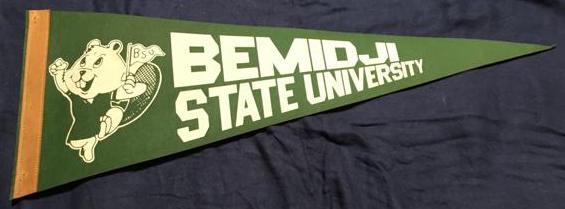Bemidji State University
Minnesota
1919



To avoid assigning duplicate hood linings to colleges and universities that used the same school colors, the Intercollegiate Bureau of Academic Costume (IBAC) used different types of heraldic patterns to divide the two or more colors in an academic hood. In IBAC lists from 1927 and 1948, a number of hood lining patterns were described as “[color] above [color]” or “[color] over [color]”, which referred either to a hood lining divided per chevron, per reversed chevron, or per bar. Unfortunately, today it is not usually known which of these three patterns the Bureau intended to describe.
For instance, the IBAC assigned St. Mary’s College in Kentucky a hood lining that was “green above white” no later than 1927, according to an IBAC list from that period. In the 1940s or 1950s, the IBAC assigned Bemidji State College a similar hood lining (“green over white”), which was how the hood lining was described in an IBAC list from 1972. How St. Mary’s colors were divided is currently unknown (the college went defunct in 1976), but Bemidji’s colors may have been divided per chevron because a list compiled by Kevin Sheard in Academic Heraldry in America (1962) described the college’s hood lining as “Kelly green” above white, divided per chevron. Sheard’s description of Bemidji’s green is not typical and probably reflects the popularity of lighter and brighter colors in American culture during the 1950s and 1960s.
Here, to resemble the snow covered pine trees that inspired the students to choose green and white in 1920, the university’s forest green color has been used, the Intercollegiate Bureau’s heraldic division of the green and white colors has been inverted, and the locations of the colors have been transposed.


In February 1920, there was a meeting of Bemidji State Normal School students to select school colors for the college. One of the students looked out the window, saw how beautiful the snow-covered pine trees looked, and suggested that green and white become the colors for the college. A unanimous vote made the colors official. The college typically used a forest green or true green color.
